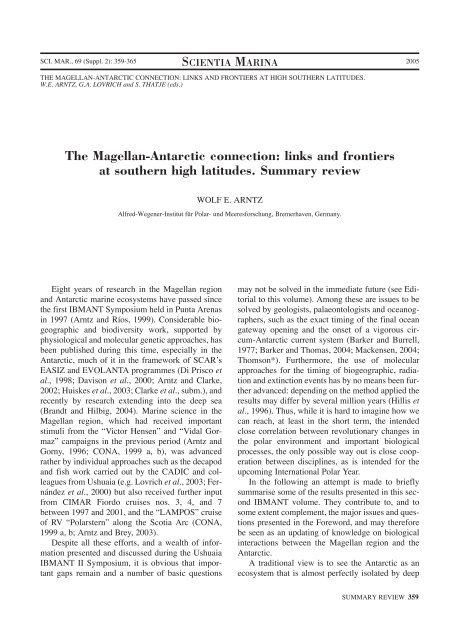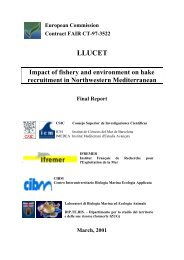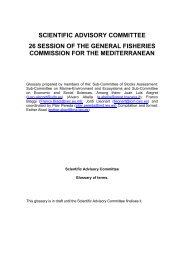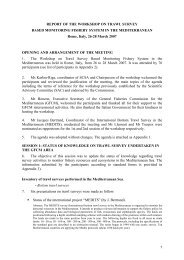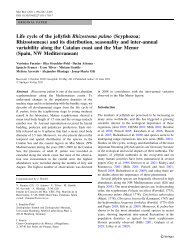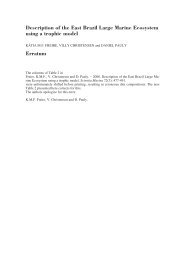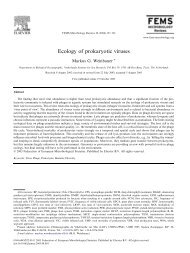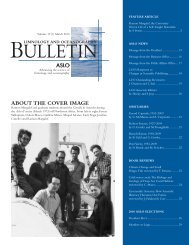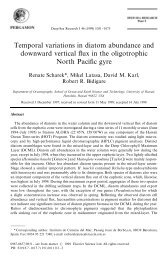The Magellan-Antarctic connection: links and frontiers at southern ...
The Magellan-Antarctic connection: links and frontiers at southern ...
The Magellan-Antarctic connection: links and frontiers at southern ...
You also want an ePaper? Increase the reach of your titles
YUMPU automatically turns print PDFs into web optimized ePapers that Google loves.
SCI. MAR., 69 (Suppl. 2): 359-365 SCIENTIA MARINA 2005<br />
THE MAGELLAN-ANTARCTIC CONNECTION: LINKS AND FRONTIERS AT HIGH SOUTHERN LATITUDES.<br />
W.E. ARNTZ, G.A. LOVRICH <strong>and</strong> S. THATJE (eds.)<br />
<strong>The</strong> <strong>Magellan</strong>-<strong>Antarctic</strong> <strong>connection</strong>: <strong>links</strong> <strong>and</strong> <strong>frontiers</strong><br />
<strong>at</strong> <strong>southern</strong> high l<strong>at</strong>itudes. Summary review<br />
WOLF E. ARNTZ<br />
Alfred-Wegener-Institut für Polar- und Meeresforschung, Bremerhaven, Germany.<br />
Eight years of research in the <strong>Magellan</strong> region<br />
<strong>and</strong> <strong>Antarctic</strong> marine ecosystems have passed since<br />
the first IBMANT Symposium held in Punta Arenas<br />
in 1997 (Arntz <strong>and</strong> Ríos, 1999). Considerable biogeographic<br />
<strong>and</strong> biodiversity work, supported by<br />
physiological <strong>and</strong> molecular genetic approaches, has<br />
been published during this time, especially in the<br />
<strong>Antarctic</strong>, much of it in the framework of SCAR’s<br />
EASIZ <strong>and</strong> EVOLANTA programmes (Di Prisco et<br />
al., 1998; Davison et al., 2000; Arntz <strong>and</strong> Clarke,<br />
2002; Huiskes et al., 2003; Clarke et al., subm.), <strong>and</strong><br />
recently by research extending into the deep sea<br />
(Br<strong>and</strong>t <strong>and</strong> Hilbig, 2004). Marine science in the<br />
<strong>Magellan</strong> region, which had received important<br />
stimuli from the “Victor Hensen” <strong>and</strong> “Vidal Gormaz”<br />
campaigns in the previous period (Arntz <strong>and</strong><br />
Gorny, 1996; CONA, 1999 a, b), was advanced<br />
r<strong>at</strong>her by individual approaches such as the decapod<br />
<strong>and</strong> fish work carried out by the CADIC <strong>and</strong> colleagues<br />
from Ushuaia (e.g. Lovrich et al., 2003; Fernández<br />
et al., 2000) but also received further input<br />
from CIMAR Fiordo cruises nos. 3, 4, <strong>and</strong> 7<br />
between 1997 <strong>and</strong> 2001, <strong>and</strong> the “LAMPOS” cruise<br />
of RV “Polarstern” along the Scotia Arc (CONA,<br />
1999 a, b; Arntz <strong>and</strong> Brey, 2003).<br />
Despite all these efforts, <strong>and</strong> a wealth of inform<strong>at</strong>ion<br />
presented <strong>and</strong> discussed during the Ushuaia<br />
IBMANT II Symposium, it is obvious th<strong>at</strong> important<br />
gaps remain <strong>and</strong> a number of basic questions<br />
may not be solved in the immedi<strong>at</strong>e future (see Editorial<br />
to this volume). Among these are issues to be<br />
solved by geologists, palaeontologists <strong>and</strong> oceanographers,<br />
such as the exact timing of the final ocean<br />
g<strong>at</strong>eway opening <strong>and</strong> the onset of a vigorous circum-<strong>Antarctic</strong><br />
current system (Barker <strong>and</strong> Burrell,<br />
1977; Barker <strong>and</strong> Thomas, 2004; Mackensen, 2004;<br />
Thomson*). Furthermore, the use of molecular<br />
approaches for the timing of biogeographic, radi<strong>at</strong>ion<br />
<strong>and</strong> extinction events has by no means been further<br />
advanced: depending on the method applied the<br />
results may differ by several million years (Hillis et<br />
al., 1996). Thus, while it is hard to imagine how we<br />
can reach, <strong>at</strong> least in the short term, the intended<br />
close correl<strong>at</strong>ion between revolutionary changes in<br />
the polar environment <strong>and</strong> important biological<br />
processes, the only possible way out is close cooper<strong>at</strong>ion<br />
between disciplines, as is intended for the<br />
upcoming Intern<strong>at</strong>ional Polar Year.<br />
In the following an <strong>at</strong>tempt is made to briefly<br />
summarise some of the results presented in this second<br />
IBMANT volume. <strong>The</strong>y contribute to, <strong>and</strong> to<br />
some extent complement, the major issues <strong>and</strong> questions<br />
presented in the Foreword, <strong>and</strong> may therefore<br />
be seen as an upd<strong>at</strong>ing of knowledge on biological<br />
interactions between the <strong>Magellan</strong> region <strong>and</strong> the<br />
<strong>Antarctic</strong>.<br />
A traditional view is to see the <strong>Antarctic</strong> as an<br />
ecosystem th<strong>at</strong> is almost perfectly isol<strong>at</strong>ed by deep<br />
SUMMARY REVIEW 359
sea, circular currents <strong>and</strong> powerful fronts between<br />
w<strong>at</strong>er bodies of different properties. But how hermetic<br />
are these fronts? Mesoscale eddies are a dominant<br />
fe<strong>at</strong>ure of circul<strong>at</strong>ion <strong>and</strong> play a fundamental<br />
role in the transport of w<strong>at</strong>er along <strong>and</strong> across the<br />
<strong>Antarctic</strong> Circumpolar Current (ACC; Glorioso et<br />
al.). Cross-frontal eddy transport <strong>and</strong> me<strong>and</strong>ering<br />
have been encountered in particular along the Subantarctic<br />
Front <strong>and</strong> the <strong>southern</strong> ACC Front. <strong>The</strong>se<br />
results are of utmost importance in the present situ<strong>at</strong>ion<br />
of a warming planet, in which small increases<br />
in Southern Ocean w<strong>at</strong>er temper<strong>at</strong>ure may result in<br />
increased settling success of alien meroplanktonic<br />
larvae south of the Polar Front (Th<strong>at</strong>je <strong>and</strong> Fuentes,<br />
2003), where the benthic biota may not have developed<br />
defence mechanisms.<br />
Diversity <strong>and</strong> distribution of zooplankton, compared<br />
to the benthos, are much less affected by the<br />
Polar Front, although the cold-w<strong>at</strong>er convergence of<br />
the Polar Front is more important than the front<br />
between the tropics <strong>and</strong> subtropics. Worldwide,<br />
species richness of benthos is several degrees of<br />
magnitude higher than th<strong>at</strong> of plankton, whose ecological<br />
relevance is not paralleled by its diversity.<br />
However, zooplankton species in the Atlantic sector<br />
of the Southern Ocean contribute an important share<br />
to the world-wide inventory of this group, which is<br />
almost twice as high as th<strong>at</strong> of benthos. On the other<br />
h<strong>and</strong>, benthic endemism in these cold w<strong>at</strong>ers is<br />
much higher than th<strong>at</strong> of plankton. Detachment from<br />
the bottom apparently results in wider geographic<br />
ranges <strong>and</strong> lower degrees of endemism (Boltovskoy<br />
et al.).<br />
A first study of mesozooplankton was carried out<br />
in the northern Beagle Channel near Ushuaia (Fernández<br />
<strong>and</strong> Hoffmeyer). Copepods were the dominant<br />
taxon. Most of the species found are typical of<br />
the Subantarctic, but some common species are present<br />
in high numbers also <strong>at</strong> <strong>Antarctic</strong> coastal sites,<br />
confirming th<strong>at</strong> the Polar Front is probably not a<br />
major geographic barrier for the distribution of<br />
pelagic species.<br />
Pelagobenthic coupling has been well studied in<br />
the <strong>Antarctic</strong> but sadly little is known from the <strong>Magellan</strong><br />
region. <strong>The</strong> marked spring-summer peak of<br />
particle fluxes in the <strong>Antarctic</strong> w<strong>at</strong>er column <strong>and</strong> <strong>at</strong><br />
shallower depths is concealed <strong>at</strong> the deeper seabeds<br />
due to suspension <strong>and</strong> l<strong>at</strong>eral advection. Faecal pellets<br />
of various origins are the main constituents of<br />
the biogenic m<strong>at</strong>ter flux, but the role of distinct taxa<br />
requires further study. Aggreg<strong>at</strong>ion of particles<br />
favours the transfer of high-quality organic m<strong>at</strong>ter to<br />
the benthos. Both faecal pellets <strong>and</strong> aggreg<strong>at</strong>es<br />
reduce the residence time of biogenic m<strong>at</strong>ter in the<br />
w<strong>at</strong>er column <strong>and</strong> favour the accumul<strong>at</strong>ion of highly<br />
nutritive m<strong>at</strong>erial on the seafloor. <strong>The</strong> suspected<br />
poor species number <strong>and</strong> abundance of meroplanktonic<br />
larvae needs further confirm<strong>at</strong>ion (Schnack-<br />
Schiel <strong>and</strong> Isla).<br />
<strong>The</strong> P<strong>at</strong>agonia-high Weddell Sea gradient is not<br />
the only l<strong>at</strong>itudinal gradient presently under study.<br />
Marine research is also being undertaken along Victoria<br />
L<strong>and</strong> (Ross Sea) between 72 <strong>and</strong> 86°S by a<br />
consortium of Italian, New Zeal<strong>and</strong> <strong>and</strong> U.S. scientists<br />
(Berkman et al.). <strong>The</strong> preliminary results show<br />
th<strong>at</strong> this area will yield highly interesting comparisons<br />
with results obtained in the Weddell Sea,<br />
including an extension to even higher l<strong>at</strong>itudes. As<br />
only part of the Victoria L<strong>and</strong> gradient has an ice<br />
shelf coast, one important research issue might be to<br />
find out to wh<strong>at</strong> extent ice shelves influence the<br />
composition of the “circum-<strong>Antarctic</strong>” fauna <strong>and</strong><br />
flora; e.g. missing macroalgae <strong>and</strong> rare occurrence<br />
of scallops in the Weddell Sea vs. abundant popul<strong>at</strong>ions<br />
in the Ross Sea.<br />
<strong>The</strong> Scotia Arc is the only shallow-w<strong>at</strong>er <strong>and</strong><br />
isl<strong>and</strong> bridge linking the <strong>Antarctic</strong> nowadays with<br />
the surrounding continents. It has now amongst the<br />
fastest r<strong>at</strong>es of environmental change measured.<br />
Shallow-w<strong>at</strong>er benthos was studied by Barnes in the<br />
context of this change. Due to the long dark winter,<br />
benthic life is mostly in the slow lane. During summer,<br />
shallow communities are intensely disturbed by<br />
ice scour <strong>and</strong> wave action, resulting in a lack of<br />
shore zon<strong>at</strong>ion <strong>and</strong> low species richness contrary to<br />
the conditions in the subtidal. As in deeper w<strong>at</strong>er<br />
(see Arntz et al.) there is no consistent l<strong>at</strong>itudinal<br />
cline in species richness, r<strong>at</strong>her a dependency on the<br />
degree of isol<strong>at</strong>ion of various sites, <strong>and</strong> some taxa<br />
are much more speciose than in <strong>southern</strong> hemisphere<br />
temper<strong>at</strong>e w<strong>at</strong>ers. <strong>The</strong> isl<strong>and</strong>s of the Arc<br />
might serve as stepping stones for those faunal <strong>and</strong><br />
floral elements which have dispersal capabilities to<br />
bridge short deep-sea distances. Eastward transport<br />
with the ACC is much more likely than the return in<br />
westerly direction, but the Weddell Sea Eddy, the<br />
East Wind Drift, <strong>and</strong> transport across the Polar Front<br />
by eddies origin<strong>at</strong>ing from the valve effect of the<br />
Drake Passage (Glorioso et al.) might also contribute<br />
to exchange processes, which under the present<br />
fast r<strong>at</strong>es of clim<strong>at</strong>e change might result in successful<br />
colonis<strong>at</strong>ion by “aliens”.<br />
Another shallow-w<strong>at</strong>er study (to 40 m depth)<br />
deals with the distribution of actinians along the<br />
360 W.E. ARNTZ
Chilean coast (Häussermann <strong>and</strong> Försterra). A<br />
total of 32 species of Actiniaria <strong>and</strong> Corallimorpharia<br />
were found, 23 of which occurred in the wellstructured<br />
<strong>southern</strong> fjord system. A comparison<br />
based on extensive liter<strong>at</strong>ure is made with d<strong>at</strong>a from<br />
Argentina (18 overlapping spp. of a total of 70) <strong>and</strong><br />
the <strong>Antarctic</strong> (13 overlapping species). Many liter<strong>at</strong>ure<br />
records need revision or confirm<strong>at</strong>ion.<br />
Studying the 78 bryozoan species collected during<br />
the LAMPOS cruise, Moyano distinguished the<br />
isl<strong>and</strong> groups east <strong>and</strong> south of Shag Rocks as<br />
<strong>Antarctic</strong>, whereas Burdwood Bank clustered with<br />
Tierra del Fuego. Considering all records hitherto<br />
(214 spp.), the <strong>Antarctic</strong> Peninsula clustered with<br />
the Scotia Arc, whereas a second cluster comprised<br />
the <strong>Magellan</strong> region <strong>and</strong> the Falkl<strong>and</strong>s. Using bryozoan<br />
m<strong>at</strong>erial (genera) from Australia <strong>and</strong> New<br />
Zeal<strong>and</strong>, these areas join the <strong>Magellan</strong> region.<br />
From bivalve m<strong>at</strong>erial (74 spp.) sampled during<br />
the same expedition along the Scotia Arc, Zelaya<br />
noticed a higher similarity with the Weddell Sea<br />
(50-85% overlap) than with P<strong>at</strong>agonia <strong>and</strong> the Falkl<strong>and</strong><br />
(Malvinas) Isl<strong>and</strong>s (12-29%). <strong>The</strong> high <strong>Antarctic</strong><br />
Weddell Sea <strong>and</strong> P<strong>at</strong>agonia/Falkl<strong>and</strong>s only<br />
shared 10% of their species. Bivalves from South<br />
Georgia were predominantly <strong>Antarctic</strong>. Bivalve distribution<br />
supports the placement of the Scotia Arc<br />
isl<strong>and</strong>s within the <strong>Antarctic</strong> region.<br />
<strong>The</strong> species number of polychaetes in the south<br />
Chilean channel system from m<strong>at</strong>erial collected in<br />
the last 124 yr amounts to 431 (Montiel et al.).<br />
Based on this m<strong>at</strong>erial the authors divided the <strong>Magellan</strong><br />
region into an Atlantic <strong>and</strong> a Pacific subregion,<br />
both with 80% of which<br />
were new to science (George). <strong>The</strong> author emphasises<br />
the need for studies <strong>at</strong> species level, because<br />
species often show a much more restricted distribution<br />
than higher taxa. A second harpacticoid study<br />
was carried out in the Potter Cove (South Shetl<strong>and</strong>s)<br />
(Veit-Köhler), with particular emphasis on the two<br />
species Pseudotachidius jubanyensis <strong>and</strong> Scottopsyllus<br />
praecipuus. Besides presenting numbers, the<br />
biovolume of the meiobenthic copepods was measured,<br />
the l<strong>at</strong>ter being rel<strong>at</strong>ed r<strong>at</strong>her to total organic<br />
m<strong>at</strong>ter than to the C-N r<strong>at</strong>io, chloroplastic equivalents,<br />
grain size or depth. However, neither of the<br />
two specifically studied species showed a rel<strong>at</strong>ion to<br />
total organic m<strong>at</strong>ter.<br />
A molecular survey of within-species genetic<br />
diversity on the <strong>Antarctic</strong> isopod Glyptonotus<br />
antarcticus, hitherto considered a single species,<br />
revealed high variability in the mitochondrial LSU<br />
(16S) gene (Held <strong>and</strong> Wägele). From a total of<br />
eleven unique mitochondrial haplotypes four groups<br />
were differenti<strong>at</strong>ed, which may represent cryptic<br />
species <strong>at</strong> the <strong>Antarctic</strong> Peninsula, in the Ross Sea<br />
<strong>and</strong> in the SE Weddell Sea (2).<br />
<strong>The</strong> species inventories of two malacostracan<br />
crustacean taxa were upd<strong>at</strong>ed in the south of the<br />
<strong>Magellan</strong> region. Shallow-w<strong>at</strong>er Asellota (isopods)<br />
from the Beagle Channel now amount to 23 species<br />
(Doti et al.). Faunistic affinities were high (65%)<br />
with the Straits of <strong>Magellan</strong>; the entire <strong>Magellan</strong><br />
region showed 30% overlap with the Scotia Arc <strong>and</strong><br />
26% with the <strong>Antarctic</strong> Peninsula. Species richness<br />
<strong>and</strong> faunal affinities of gammaridean <strong>and</strong> corophiidean<br />
amphipods in <strong>southern</strong> Tierra del Fuego were<br />
studied by Chiesa et al. <strong>The</strong> authors identified 61—<br />
mostly small—species, most of which belong to the<br />
Phoxocephalidae, Stenothoidae <strong>and</strong> Lysianassidae.<br />
Of these 39% were endemic to the <strong>Magellan</strong> region.<br />
Decapod distribution on the northern <strong>and</strong> <strong>southern</strong><br />
branch of the Scotia Arc reveals a clear separ<strong>at</strong>ion<br />
of <strong>Magellan</strong> <strong>and</strong> <strong>Antarctic</strong> elements respectively<br />
(Lovrich et al.), with an occurrence of both reptant<br />
<strong>and</strong> caridean species on the northern, <strong>and</strong> an<br />
impoverished caridean fauna on the <strong>southern</strong><br />
branch. However, South Georgia holds a transitional<br />
position in combining these elements, which<br />
might be explained by occasional changes in the<br />
position of the Polar Front, as suggested in the<br />
review by Arntz et al. Differences were detected in<br />
the reproductive cycle of Notocrangon antarcticus<br />
<strong>and</strong> in the oocyte number of Munida subrugosa<br />
from different localities. A new index measuring the<br />
energy invested in reproduction revealed th<strong>at</strong> this<br />
investment is species-specific, larger in caridean<br />
shrimps than in gal<strong>at</strong>heid crabs, <strong>and</strong> independent of<br />
the sampling site. <strong>The</strong> decapod faunas from <strong>southern</strong><br />
Chile <strong>and</strong> <strong>southern</strong> Argentina combined in the<br />
<strong>Magellan</strong>ic Biogeographic Province are closely<br />
rel<strong>at</strong>ed, but show little associ<strong>at</strong>ion with the circum-<br />
<strong>Antarctic</strong> decapod fauna (Boschi <strong>and</strong> Gavio), con-<br />
SUMMARY REVIEW 361
firming work published by e.g., Gorny (1999) <strong>and</strong><br />
Th<strong>at</strong>je et al. (2005).<br />
A Belgian interactive d<strong>at</strong>a base on <strong>Antarctic</strong><br />
echinoids (south of the Polar Front) now comprises<br />
81 species (David et al.), summarising taxonomic,<br />
ecological, morphological <strong>and</strong> distributional d<strong>at</strong>a<br />
<strong>and</strong> the sources of inform<strong>at</strong>ion. <strong>The</strong> CD-Rom is distributed<br />
with this volume.<br />
A similar distribution as in the decapods (northern<br />
branch of the Scotia Arc: <strong>Magellan</strong>, <strong>southern</strong><br />
branch: <strong>Antarctic</strong>) was found in 42 ascidian species<br />
collected during three Spanish expeditions (Ramos-<br />
Esplá et al.). South Georgia again holds a transitional<br />
position, with an intermedi<strong>at</strong>e ascidian fauna<br />
between the <strong>Antarctic</strong> Province <strong>and</strong> the <strong>Magellan</strong><br />
region. Another ascidian study from the LAMPOS<br />
cruise, yielding 25 species or morphospecies, also<br />
st<strong>at</strong>es a transitional role of South Georgia, as it represents<br />
the northern limit for <strong>Antarctic</strong> species <strong>and</strong><br />
the <strong>southern</strong> limit for <strong>Magellan</strong>ic species (T<strong>at</strong>ián et<br />
al.). <strong>The</strong> lower depth limits of the two studies (600<br />
m) were identical, but the l<strong>at</strong>ter upper range (250 m)<br />
was much deeper than the former (10 m), which<br />
may explain the different species numbers.<br />
Mega- <strong>and</strong> macrobenthic associ<strong>at</strong>ions were sampled<br />
in the south Chilean fjord system by Ríos et al.<br />
using an Agassiz trawl. A total of 131 species were<br />
collected, with echinoderms (47 spp.) <strong>and</strong> polychaetes<br />
(46 spp.) as dominant taxa. Marked differences<br />
were found between the impoverished benthic<br />
fauna in the fjords <strong>and</strong> channels off the South P<strong>at</strong>agonian<br />
Icefields, revealing strong glacier impact, <strong>and</strong><br />
the richer fauna in the Straits of <strong>Magellan</strong>.<br />
Progress in macrobenthic studies on the <strong>Antarctic</strong><br />
<strong>and</strong> <strong>Magellan</strong> shelves <strong>and</strong> upper slopes since the<br />
first IBMANT Symposium is reported by Arntz et<br />
al., placing the emphasis on shipboard sampling.<br />
Considerable progress is visible in biodiversity <strong>and</strong><br />
biogeography on the <strong>Magellan</strong>-<strong>Antarctic</strong> l<strong>at</strong>itudinal<br />
gradient, the influence of disturbance on biodiversity,<br />
<strong>and</strong> the general role of evolutionary <strong>and</strong> ecological<br />
factors in shaping past <strong>and</strong> present-day environmental<br />
conditions, species composition <strong>and</strong> distribution,<br />
<strong>and</strong> ecosystem functioning. Benthic life<br />
str<strong>at</strong>egies <strong>and</strong> physiological adapt<strong>at</strong>ions (see Pörtner<br />
et al.) have also received due <strong>at</strong>tention. Methods<br />
have been improved substantially, <strong>and</strong> modern<br />
approaches play an increasing role. On the other<br />
h<strong>and</strong>, much remains to be done. Research in the<br />
<strong>Magellan</strong> region, which has not advanced with the<br />
pace experienced in the <strong>Antarctic</strong>, must be<br />
enhanced. <strong>The</strong> same is true for other undersampled<br />
areas, such as most of the East <strong>Antarctic</strong>, Bouvet<br />
Isl<strong>and</strong> or the Bellingshausen Sea, or the rare shallow<br />
sites in the Weddell Sea. Areas recently freed from<br />
ice shelves such as the Larsen ice shelf should be<br />
studied intensely. Much more interdisciplinary work<br />
is necessary to tackle the numerous open questions<br />
about the rel<strong>at</strong>ions between environmental change<br />
<strong>and</strong> organismic evolution in the Subantarctic <strong>and</strong><br />
<strong>Antarctic</strong>. Molecular methods need to be improved,<br />
<strong>and</strong> valid<strong>at</strong>ion with the help of palaeontologists<br />
increased in order to reach more concise d<strong>at</strong>ings of<br />
evolutionary processes.<br />
Based on comparisons of fish <strong>and</strong> invertebr<strong>at</strong>e<br />
metabolism along l<strong>at</strong>itudinal gradients in both hemispheres,<br />
Pörtner et al. analyse characteristics of<br />
temper<strong>at</strong>ure dependent metabolic adapt<strong>at</strong>ion <strong>and</strong><br />
their consequences for changes in energy budgets.<br />
Temper<strong>at</strong>ure sensitivity of growth is considered a<br />
key component for energy budgets. Apparently, n<strong>at</strong>ural<br />
selection helps individuals to reach high energy<br />
efficiency <strong>and</strong> maximized growth, but is constrained<br />
by limited energy availability <strong>and</strong> temper<strong>at</strong>ure.<br />
However, the assumption th<strong>at</strong> levels of metabolic<br />
r<strong>at</strong>es could be estim<strong>at</strong>ed just from mean temper<strong>at</strong>ures<br />
is too simple, <strong>and</strong> there are distinct differences<br />
between the permanently low temper<strong>at</strong>ure ecosystems<br />
of the <strong>Antarctic</strong> as compared to the Subarctic<br />
<strong>and</strong> Arctic, where temper<strong>at</strong>ure variability is gre<strong>at</strong>er.<br />
This variability causes a rise in maintenance costs <strong>at</strong><br />
the expense of growth but in favour of agility <strong>and</strong><br />
foraging capacity, whereas savings in maintenance<br />
costs, setting free energy for growth, are maximised<br />
under the permanently low temper<strong>at</strong>ures of the<br />
<strong>Antarctic</strong>. <strong>The</strong> authors emphasise th<strong>at</strong> their energy<br />
budget hypothesis <strong>and</strong> the suggested trade-offs<br />
between life style, agility <strong>and</strong> growth performance<br />
explain most of the p<strong>at</strong>terns observed in stenotherms<br />
<strong>and</strong> eurytherms on a l<strong>at</strong>itudinal gradient.<br />
Ultraviolet B radi<strong>at</strong>ion reaching the surface of<br />
the Southern Ocean has significantly increased due<br />
to the reduction of the str<strong>at</strong>ospheric ozone. Based on<br />
the investig<strong>at</strong>ion of a phytoflagell<strong>at</strong>e <strong>and</strong> a di<strong>at</strong>om,<br />
Hern<strong>and</strong>o et al. conclude th<strong>at</strong> the balance between<br />
damage <strong>and</strong> repair after UV radi<strong>at</strong>ion involves the<br />
combined action of several internal factors in the<br />
cell, suggesting th<strong>at</strong> exposure to mild oxid<strong>at</strong>ive<br />
stress initi<strong>at</strong>es adaptive responses th<strong>at</strong> provide<br />
increased protection against more severe stress. In<br />
another study, Malanga et al. investig<strong>at</strong>ed the effect<br />
of air exposure <strong>and</strong> temper<strong>at</strong>ure fluctu<strong>at</strong>ions <strong>at</strong> different<br />
tidal levels on oxid<strong>at</strong>ive stress parameters in<br />
gills of <strong>Magellan</strong> <strong>and</strong> <strong>Antarctic</strong> limpets (Nacella<br />
362 W.E. ARNTZ
spp.). In the Beagle Channel, N. magellanica lives in<br />
the intertidal <strong>and</strong> suffers high environmental variability,<br />
whereas N. deaur<strong>at</strong>a is usually covered by<br />
shallow w<strong>at</strong>er <strong>and</strong> experiences compar<strong>at</strong>ively constant<br />
conditions. <strong>The</strong> <strong>Antarctic</strong> N. concinna is found<br />
both <strong>at</strong> inter- <strong>and</strong> subtidal levels. <strong>Antarctic</strong> Peninsula<br />
specimens from the upper intertidal showed significantly<br />
increased activities of c<strong>at</strong>alase <strong>and</strong> superoxide<br />
dismutase as compared to their rel<strong>at</strong>ives <strong>at</strong><br />
lower levels. No pronounced difference in oxid<strong>at</strong>ive<br />
stress parameters or in oxygen uptake was detected<br />
between the two limpets from the Beagle Channel.<br />
<strong>The</strong> proposed mechanism th<strong>at</strong> controls oxid<strong>at</strong>ive<br />
stress in the intertidal N. magellanica could, according<br />
to these authors, be the way in which the limpets<br />
control the content of c<strong>at</strong>alytically active iron II<br />
(including reduction r<strong>at</strong>es of iron III) in their tissues.<br />
<strong>The</strong> conclusion from the two contributions is th<strong>at</strong><br />
coping with a dem<strong>and</strong>ing environment requires<br />
complex metabolic adjustments to minimise intracellular<br />
damage.<br />
<strong>Antarctic</strong> fish (Notothenioidei) deserve special<br />
<strong>at</strong>tention because unlike most other fish taxa, this<br />
group adapted successfully to cold conditions. <strong>The</strong><br />
reproductive development of notothenioid fish<br />
caught in the Scotia Arc during the LAMPOS cruise<br />
differed substantially among the different species.<br />
Fecundity in channichthyids was lower than in<br />
nototheniids. Spawning revealed the same characteristics<br />
as in the high <strong>Antarctic</strong>, with delayed m<strong>at</strong>urity,<br />
moder<strong>at</strong>e fecundity, a single spawning per year<br />
<strong>and</strong> prolonged gametogenesis (Vanella et al.).<br />
Vanella <strong>and</strong> Calvo studied the influence of temper<strong>at</strong>ure<br />
on the routine metabolic r<strong>at</strong>e of Subantarctic<br />
teleosts <strong>and</strong> compared the results with the r<strong>at</strong>es of<br />
species with different geographical distributions. In<br />
the 5 studied species <strong>and</strong> all tested temper<strong>at</strong>ures,<br />
body mass <strong>and</strong> oxygen consumption showed a positive<br />
correl<strong>at</strong>ion. A massive drop in temper<strong>at</strong>ure<br />
caused a significant reduction in oxygen consumption.<br />
Pelagic species had a higher O 2<br />
consumption<br />
than sluggish demersal species. <strong>The</strong> authors conclude<br />
th<strong>at</strong> similar to fish in the <strong>Antarctic</strong> proper,<br />
Subantarctic fish have not developed metabolic cold<br />
adapt<strong>at</strong>ion.<br />
<strong>The</strong> axial muscle of <strong>Antarctic</strong> <strong>and</strong> some Subantarctic<br />
notothenioids contains exceptionally large<br />
muscle fibres <strong>and</strong> a low fibre number. Species from<br />
both regions showed no differences in the number<br />
<strong>and</strong> type composition of fibres, or in ATPase activity,<br />
fibre recruitment <strong>and</strong> swimming performance.<br />
However, fibre number <strong>and</strong> fibre diameter decrease<br />
in the more derived families, <strong>and</strong> the dur<strong>at</strong>ion of the<br />
cell cycle showed cold compens<strong>at</strong>ion in the <strong>Antarctic</strong><br />
Harpagifer species in comparison with its Subantarctic<br />
rel<strong>at</strong>ive. Apparently, the diversific<strong>at</strong>ion of<br />
<strong>Antarctic</strong> notothenioids was associ<strong>at</strong>ed with a sizespecific<br />
reduction in fibre numbers <strong>and</strong> an increase<br />
in fibre diameter. This finding presents a gre<strong>at</strong><br />
opportunity to study the temper<strong>at</strong>ure-rel<strong>at</strong>ed mechanisms<br />
of muscle growth in an evolutionary context<br />
(Fernández et al.).<br />
Stalked crinoids were a conspicuous member of<br />
shallow marine benthic communities throughout<br />
much of the Palaeozoic, before they were outcompeted<br />
by the Mesozoic increase of durophagous pred<strong>at</strong>ors<br />
(Aronson <strong>and</strong> Blake, 2001) <strong>and</strong> gave way to the<br />
mobile forms th<strong>at</strong> prevail in the benthos today, with<br />
the exception of some refuges such as the deep sea.<br />
While post-l<strong>at</strong>e Cretaceous shallow w<strong>at</strong>er records of<br />
isocrinids are generally very rare, these forms were<br />
still abundant in <strong>Antarctic</strong> shallow w<strong>at</strong>er of the La<br />
Meseta Form<strong>at</strong>ion of Seymour Isl<strong>and</strong> in the l<strong>at</strong>e<br />
Eocene. Malumián <strong>and</strong> Olivero report the existence<br />
of another retrograde, dense Isselicrinus popul<strong>at</strong>ion,<br />
which successfully extended its distribution into the<br />
Leticia Form<strong>at</strong>ion of Tierra del Fuego. <strong>The</strong>se occurrences<br />
in shallow w<strong>at</strong>er are in contrast with the depth<br />
distribution of stalked crinoids by th<strong>at</strong> time, which<br />
was almost entirely a deep-w<strong>at</strong>er distribution.<br />
<strong>The</strong> L<strong>at</strong>e Glacial Maximum (LGM) in the Beagle<br />
area probably occurred ca. 20,000 yr BP (Rabassa et<br />
al., 1990). By 12,000 yr BP the ice seems to have<br />
disappeared from the coasts <strong>at</strong> Pto. Williams <strong>and</strong><br />
Ushuaia, <strong>and</strong> large amounts of meltw<strong>at</strong>er were filling<br />
the Beagle Channel (Heusser, 1989, 1998). Fossil<br />
marine records were first showing up around<br />
8000 yr BP (Gordillo et al.). A diversific<strong>at</strong>ion <strong>and</strong><br />
expansion of molluscan assemblages occurred during<br />
the interval 5000-4000 yr BP, when an evolution<br />
towards modern conditions took place. Most species<br />
once established also survived l<strong>at</strong>er clim<strong>at</strong>ic deterior<strong>at</strong>ion.<br />
Both in Tierra del Fuego <strong>and</strong> in the <strong>Antarctic</strong>,<br />
molluscs are the most consistent fossil record,<br />
<strong>and</strong> all recovered taxa are extant species. Overlap of<br />
these palaeofaunas <strong>at</strong> the species level is low, as for<br />
recent species where it is
<strong>The</strong> opening of the channel system of the “Cono<br />
Sur” after the LGM may have also cre<strong>at</strong>ed p<strong>at</strong>hways<br />
for the exchange of <strong>Magellan</strong> polychaetes (Montiel<br />
et al.).<br />
An outlook based on the present<strong>at</strong>ions <strong>and</strong> discussions<br />
during the meeting is given by Thomson,<br />
who concludes th<strong>at</strong> in the face of all the uncertainties<br />
about the l<strong>at</strong>e Cenozoic geological history, the<br />
doubts about major oceanographic processes <strong>and</strong><br />
many unknown p<strong>at</strong>terns in palaeontology <strong>and</strong> evolution,<br />
the time is opportune for a truly multidisciplinary<br />
intern<strong>at</strong>ional workshop. Both IBMANT <strong>and</strong><br />
ANDEEP, under the roof of SCAR, might provide a<br />
framework for convoking the biological community,<br />
but efforts are also necessary from the other disciplines.<br />
After all, as Thomson says, the involved science<br />
communities have much to gain from each<br />
other.<br />
REFERENCES<br />
*Note: Authors without years mentioned in the text refer to this volume.<br />
Arntz, W.E. <strong>and</strong> A. Clarke (eds.). – 2002. Ecological studies in the<br />
<strong>Antarctic</strong> sea ice zone. Springer, Berlin.<br />
Arntz, W.E. <strong>and</strong> T. Brey (eds.). – 2003. <strong>The</strong> expedition ANTARK-<br />
TIS XIX/5 (LAMPOS) of RV “Polarstern” in 2002. Ber. Polarforsch.<br />
Meeresforsch., 462.<br />
Arntz, W.E. <strong>and</strong> M. Gorny (eds.). – 1996. Cruise report of the Joint<br />
Chilean-German-Italian <strong>Magellan</strong> “Victor Hensen” Campaign<br />
in 1994. Ber. Polarforsch., 190.<br />
Arntz, W.E. <strong>and</strong> C. Ríos (eds.). – 1999. <strong>Antarctic</strong>-<strong>Magellan</strong>:<br />
Ecosystems th<strong>at</strong> drifted apart. Sci Mar., 63(Suppl. 1).<br />
Aronson, R.B. <strong>and</strong> D.B. Blake. – 2001. Global clim<strong>at</strong>e change <strong>and</strong><br />
the origin of modern benthic communities in <strong>Antarctic</strong>a. Am.<br />
Zool., 41: 27-39.<br />
Barker, P.F. <strong>and</strong> J. Burrell. – 1977. <strong>The</strong> opening of Drake Passage.<br />
Marine Geology, 25: 15-34.<br />
Barker, P.F. <strong>and</strong> E. Thomas. – 2004. Origin, sign<strong>at</strong>ure <strong>and</strong> palaeoclim<strong>at</strong>ic<br />
influence of the <strong>Antarctic</strong> Circumpolar Current. Earth-<br />
Science Reviews, 66: 143-162.<br />
Br<strong>and</strong>t, A. <strong>and</strong> B. Hilbig (eds.). – 2004. ANDEEP (<strong>Antarctic</strong> benthic<br />
deep-sea biodiversity: coloniz<strong>at</strong>ion history <strong>and</strong> recent community<br />
p<strong>at</strong>terns) – a tribute to Howard L. S<strong>and</strong>ers. Deep-Sea<br />
Res. II, 51.<br />
Clarke, A.C., W.E. Arntz <strong>and</strong> C. Smith (eds.). - Subm. Proceedings<br />
of EASIZ Final Symp., Korcula, Cro<strong>at</strong>ia. Deep-Sea Res. II<br />
CONA (Comité Oceanográfico Nacional, Chile). – 1999a. Resultados<br />
crucero CIMAR-FIORDO, Resúmenes ampliados, 3: 1-144.<br />
CONA (Comité Oceanográfico Nacional, Chile). – 1999b. Resultados<br />
crucero CIMAR-FIORDO, Resúmenes ampliados, 4: 1-76<br />
Davison, W., C. Howard-Williams <strong>and</strong> P. Broady (eds.). – 2000.<br />
<strong>Antarctic</strong> ecosystems: Models for broader underst<strong>and</strong>ing. NZ<br />
N<strong>at</strong>ural Sciences, Canterbury Univ., Christchurch.<br />
Di Prisco, G., E. Pisano <strong>and</strong> A.C. Clarke (eds.). – 1998. Fishes of<br />
<strong>Antarctic</strong>a. A biological overview. Springer, Milano.<br />
Fernández, D.A., J. Calvo, C.E. Franklin <strong>and</strong> I.A. Johnston. – 2000.<br />
Muscle fibre types <strong>and</strong> size distribution in sub-<strong>Antarctic</strong><br />
nototheniod fishes. J. Fish. Biol., 56: 1295-1311.<br />
Gorny, M., 1999. – On the biogeography <strong>and</strong> ecology of the Southern<br />
Ocean decapod fauna. Sci Mar., 63(Suppl. 1): 367-382.<br />
Heusser, C.J. – 1989. L<strong>at</strong>e Qu<strong>at</strong>ernary veget<strong>at</strong>ion <strong>and</strong> clim<strong>at</strong>e of<br />
<strong>southern</strong> Tierra del Fuego. Qu<strong>at</strong>ernary Res., 31: 396-406.<br />
Heusser, C.J. – 1998. Deglacial paleoclim<strong>at</strong>e of the American sector<br />
of the Southern Ocean: L<strong>at</strong>e Glacial-Holocene records from<br />
the l<strong>at</strong>itude of Canal Beagle (55°S), Argentine Tierra del<br />
Fuego. Palaeogeogr. Palaeocl., 141: 277-301.<br />
Hillis, D.M., B.K. Mable <strong>and</strong> C. Moritz. – 1996. Applic<strong>at</strong>ions of<br />
molecular system<strong>at</strong>ics: <strong>The</strong> st<strong>at</strong>e of the field <strong>and</strong> a look into the<br />
future. In: D.M. Hillis, C. Moritz, et al., Molecular system<strong>at</strong>ics,<br />
pp. 515-543. Sunderl<strong>and</strong>, Massachussetts, Sinauer Associ<strong>at</strong>es.<br />
Huiskes, A.H.L., W.W.C. Gieskes, J. Rozema, R.M.L. Schorno,<br />
S.M. van der Vies <strong>and</strong> W.J. Wolff (eds.). – 2003. <strong>Antarctic</strong><br />
biology in a global context. Backhuys Publ., Leiden.<br />
Lovrich, G., S. Th<strong>at</strong>je, J.A. Calcagno, K. Anger <strong>and</strong> A. Kaffenberger.<br />
– 2003. Changes in biomass <strong>and</strong> chemical composition during<br />
lecithotrophic larval development of the <strong>southern</strong> king crab Lithodes<br />
santolla (Molina). J. exp. mar. Biol. Ecol., 288: 65-79.<br />
Mackensen, A. – 2004. Changing Southern Ocean palaeocircul<strong>at</strong>ion<br />
<strong>and</strong> effects on global clim<strong>at</strong>e. <strong>Antarctic</strong> Sci., 16: 369-386.<br />
Rabassa, J., D. Serr<strong>at</strong>, C. Marti <strong>and</strong> A. Coron<strong>at</strong>o. – 1990. El<br />
Tardiglacial en el Canal Beagle, Tierra del Fuego, Argentina y<br />
Chile. Actas XI Congr. Geol. Arg., 1: 290-293. San Juan,<br />
Argentina (fide S. Gordillo).<br />
Th<strong>at</strong>je, S. <strong>and</strong> V. Fuentes. – 2003. First record of anomuran <strong>and</strong><br />
brachyuran larvae (Crustacea: Decapoda) from <strong>Antarctic</strong><br />
w<strong>at</strong>ers. Polar Biol., 26: 279-282.<br />
Th<strong>at</strong>je, S., K. Anger, J.A. Calcagno, G.A. Lovrich, H.O. Pörtner<br />
<strong>and</strong> W.E. Arntz. – 2005. Challenging the cold: crabs reconquer<br />
the <strong>Antarctic</strong>. Ecology, 86: 619-625.<br />
Contributions to the volume “<strong>The</strong> <strong>Magellan</strong>-<strong>Antarctic</strong><br />
<strong>connection</strong>: Links <strong>and</strong> <strong>frontiers</strong> <strong>at</strong> high <strong>southern</strong> l<strong>at</strong>itudes”<br />
(in alphabetical order)<br />
Arntz, W.E. – 2005. <strong>The</strong> <strong>Magellan</strong>-<strong>Antarctic</strong> <strong>connection</strong>: <strong>links</strong> <strong>and</strong><br />
<strong>frontiers</strong> <strong>at</strong> <strong>southern</strong> high l<strong>at</strong>itudes. Summary review. Sci. Mar.,<br />
69(Suppl. 2): 359-365.<br />
Arntz, W.E., G. Lovrich <strong>and</strong> S. Th<strong>at</strong>je. – 2005. IBMANT II Symposium<br />
<strong>and</strong> Workshop. Foreword. Sci. Mar., 69(Suppl. 2): 3-5.<br />
Arntz, W.E., S. Th<strong>at</strong>je, D. Gerdes, J.-M. Gili, J. Gutt, A. Montiel,<br />
C. Orejas <strong>and</strong> N. Teixidó. – 2005. <strong>The</strong> <strong>Antarctic</strong>-<strong>Magellan</strong> <strong>connection</strong>:<br />
macrobenthic studies on the shelf <strong>and</strong> upper slope, a<br />
progress report. (K) Sci. Mar., 69(Suppl. 2): 237-269.<br />
Barnes, D.K.A. – 2005. Changing chain: past, present <strong>and</strong> future of<br />
the Scotia Arc’s <strong>and</strong> <strong>Antarctic</strong>a’s shallow benthic communities.<br />
(K) Sci. Mar., 69(Suppl. 2): 65-89.<br />
Berkman, P.A., R. C<strong>at</strong>taneo-Vietti, M. Chiantore, C. Howard-<br />
Williams, V. Cummings <strong>and</strong> R. Kvitek. – 2005. Marine<br />
research in the L<strong>at</strong>itudinal Gradient Project along Victoria<br />
L<strong>and</strong>, <strong>Antarctic</strong>a. (K) Sci. Mar., 69(Suppl. 2): 57-63.<br />
Boltovskoy, D., N. Correa <strong>and</strong> A. Boltovskoy. – 2005. Diversity<br />
<strong>and</strong> endemism in cold w<strong>at</strong>ers of the South Atlantic: contrasting<br />
p<strong>at</strong>terns in the plankton <strong>and</strong> the benthos. (K) Sci. Mar.,<br />
69(Suppl. 2): 17-26.<br />
Boschi, E.E. <strong>and</strong> M.A. Gavio. – 2005. On the distribution of decapod<br />
crustaceans from the <strong>Magellan</strong>ic Biogeographic Province<br />
<strong>and</strong> the <strong>Antarctic</strong> region. Sci. Mar., 69(Suppl. 2): 195-200.<br />
Chiesa, I.L., G.M. Alonso <strong>and</strong> D.G. Zelaya. – 2005. Species richness<br />
<strong>and</strong> faunistic affinities of the Gammaridea <strong>and</strong> Corophiidea<br />
(Amphipoda) from shallow w<strong>at</strong>ers of <strong>southern</strong> Tierra del<br />
Fuego, Argentina: preliminary results. Sci. Mar., 69(Suppl. 2):<br />
167-174.<br />
David, B., T. Choné, A. Festeau, R. Mooi <strong>and</strong> C. De Ridder. – 2005.<br />
Biodiversity of <strong>Antarctic</strong> echinoids: a comprehensive <strong>and</strong> interactive<br />
d<strong>at</strong>a base. Sci. Mar., 69(Suppl. 2): 201-203.<br />
Doti, B.L., D. Rocc<strong>at</strong>agli<strong>at</strong>a <strong>and</strong> D.G. Zelaya. – 2005. <strong>The</strong> shalloww<strong>at</strong>er<br />
Asellota (Crustacea: Isopoda) from the Beagle Channel:<br />
preliminary taxonomic <strong>and</strong> zoogeographical results. Sci. Mar.,<br />
69(Suppl. 2): 159-166.<br />
Fernández, D.A., J. Calvo <strong>and</strong> I.A. Johnston. – 2005. Muscle<br />
growth in <strong>Antarctic</strong> <strong>and</strong> Subantarctic notothenioid fishes. (K)<br />
Sci. Mar., 69(Suppl. 2): 325-336.<br />
Fernández-Severini, M.D. <strong>and</strong> M.S. Hoffmeyer. – 2005. Mesozooplankton<br />
assemblages in two bays of the Beagle Channel<br />
(Argentina) during January, 2001. Sci. Mar., 69(Suppl. 2): 27-37.<br />
George, K.H. – 2005. Sublittoral <strong>and</strong> b<strong>at</strong>hyal Harpacticoida (Crustacea,<br />
Copepoda) of the <strong>Magellan</strong> region. Composition, distribution<br />
<strong>and</strong> species diversity of selected major taxa. Sci. Mar.,<br />
69(Suppl. 2): 147-158.<br />
Glorioso, P.D., A.R. Piola <strong>and</strong> R.R. Leben. – 2005. Mesoscale<br />
eddies in the Subantarctic Front, southwest Atlantic. Sci. Mar.,<br />
69(Suppl. 2): 7-15.<br />
364 W.E. ARNTZ
Gordillo, S., A.M.J. Coron<strong>at</strong>o <strong>and</strong> J.O. Rabassa. – 2005. Qu<strong>at</strong>ernary<br />
molluscan faunas from the isl<strong>and</strong> of Tierra del Fuego after the<br />
Last Glacial Maximum. Sci. Mar., 69(Suppl. 2): 337-348.<br />
Häussermann, V. <strong>and</strong> G. Försterra. – 2005. Distribution p<strong>at</strong>terns of<br />
Chilean shallow-w<strong>at</strong>er sea anemones (Cnidaria: Anthozoa:<br />
Actiniaria, Corallimorpharia); with a discussion of the taxonomic<br />
<strong>and</strong> zoogeographic rel<strong>at</strong>ionships between the actinofauna<br />
of the SE Pacific, SW Atlantic <strong>and</strong> the <strong>Antarctic</strong>. Sci. Mar.,<br />
69(Suppl. 2): 91-102.<br />
Held, C. <strong>and</strong> J.-W. Wägele. – 2005. Cryptic speci<strong>at</strong>ion in the giant<br />
<strong>Antarctic</strong> isopod Glyptonotus antarcticus (Isopoda, Valvifera,<br />
Chaetiliidae). Sci. Mar., 69(Suppl. 2): 175-181.<br />
Hern<strong>and</strong>o, M., G. Malanga <strong>and</strong> G.A. Ferreyra. – 2005. Oxyd<strong>at</strong>ive<br />
stress <strong>and</strong> antioxidant defences gener<strong>at</strong>ed by solar UV in a<br />
Subantarctic marine phytoflagell<strong>at</strong>e. Sci. Mar., 69(Suppl. 2):<br />
287-295.<br />
Lovrich, G.A., M.C. Romero, F. Tapella <strong>and</strong> S. Th<strong>at</strong>je. – 2005. Distribution,<br />
reproductive <strong>and</strong> energetic conditions of decapod<br />
crustaceans along the Scotia Arc (Southern Ocean). Sci. Mar.,<br />
69(Suppl. 2): 183-193.<br />
Malanga, G., M.S. Estevez, J. Calvo, D. Abele <strong>and</strong> S. Puntarulo. –<br />
2005. Oxid<strong>at</strong>ive stress in gills of limpets from the Beagle Channel:<br />
comparison with limpets from the <strong>Antarctic</strong>. Sci. Mar.,<br />
69(Suppl. 2): 297-304.<br />
Malumian, N. <strong>and</strong> E. Olivero. – 2005. Shallow-w<strong>at</strong>er l<strong>at</strong>e middle<br />
Eocene crinoids from Tierra del Fuego: a new <strong>southern</strong> record<br />
of a retrograde community structure. Sci. Mar., 69(Suppl. 2):<br />
349-353.<br />
Montiel, A., D. Gerdes <strong>and</strong> W.E. Arntz. – 2005. Distributional p<strong>at</strong>terns<br />
of shallow-w<strong>at</strong>er polychaetes in the <strong>Magellan</strong> region: a<br />
zoogeographical <strong>and</strong> ecological synopsis. Sci. Mar., 69(Suppl.<br />
2): 123-133.<br />
Moyano, H.I. – 2005. Scotia Arc bryozoans from the LAMPOS<br />
expedition: a narrow bridge between two different faunas. Sci.<br />
Mar., 69(Suppl. 2): 103-112.<br />
Pörtner, H.O., D. Storch <strong>and</strong> O. Heilmayer. – 2005. Constraints<br />
<strong>and</strong> trade-offs in clim<strong>at</strong>e dependent adapt<strong>at</strong>ion: energy budgets<br />
<strong>and</strong> growth in a l<strong>at</strong>itudinal cline. (K) Sci. Mar., 69(Suppl.<br />
2): 271-285.<br />
Ramos-Esplá, A.A., J. Cárcel <strong>and</strong> M. Varela. – 2005. Zoogeographical<br />
rel<strong>at</strong>ionships of the littoral ascidiofauna around the<br />
<strong>Antarctic</strong> Peninsula, in the Scotia Arc <strong>and</strong> in the <strong>Magellan</strong><br />
region. Sci. Mar., 69(Suppl. 2): 215-223.<br />
Ríos, C., E. Mutschke, A. Montiel, D. Gerdes <strong>and</strong> W.E. Arntz. –<br />
2005. Soft-bottom macrobenthic faunal associ<strong>at</strong>ions in the<br />
<strong>southern</strong> Chilean glacial fjord complex. Sci. Mar., 69(Suppl. 2):<br />
225-236.<br />
Schnack-Schiel, S.B. <strong>and</strong> E. Isla. – 2005. <strong>The</strong> role of zooplankton in<br />
the pelagic-benthic coupling. (K) Sci. Mar., 69(Suppl. 2): 39-55.<br />
T<strong>at</strong>ián, M., J. Antaclia <strong>and</strong> R. Sahade. – 2005. Ascidians (Tunic<strong>at</strong>a,<br />
Ascidiacea): species distribution along the Scotia Arc. Sci.<br />
Mar., 69(Suppl. 2): 205-214.<br />
Thomson, M.R.A. – 2005. Thoughts on controls on evolution <strong>and</strong><br />
dispersal of benthos in the <strong>Magellan</strong>-Scotia Arc region: a workshop<br />
proposal. (K) Sci. Mar., 69(Suppl. 2): 355-358.<br />
Vanella, F.A. <strong>and</strong> J. Calvo. – 2005. Influence of temper<strong>at</strong>ure, habit<strong>at</strong><br />
<strong>and</strong> body mass on routine metabolic r<strong>at</strong>es of Subantarctic<br />
teleosts. Sci. Mar., 69(Suppl. 2): 317-323.<br />
Vanella, F.A., J. Calvo, E.R. Morriconi <strong>and</strong> D.R. Aureliano. – 2005.<br />
Som<strong>at</strong>ic energy content <strong>and</strong> histological analysis of the gonads<br />
in <strong>Antarctic</strong> fish from the Scotia Arc. Sci. Mar., 69(Suppl. 2):<br />
305-316.<br />
Veit-Köhler, G. – 2005. Influence of biotic <strong>and</strong> abiotic sediment<br />
factors on abundance <strong>and</strong> biomass of harpacticoid copepods in<br />
a shallow <strong>Antarctic</strong> bay. Sci. Mar., 69(Suppl. 2): 135-145.<br />
Zelaya, D.G. – 2005. <strong>The</strong> bivalves from the Scotia Arc isl<strong>and</strong>s:<br />
species richness <strong>and</strong> faunistic affinities. Sci. Mar., 69(Suppl. 2):<br />
113-122.<br />
SUMMARY REVIEW 365


